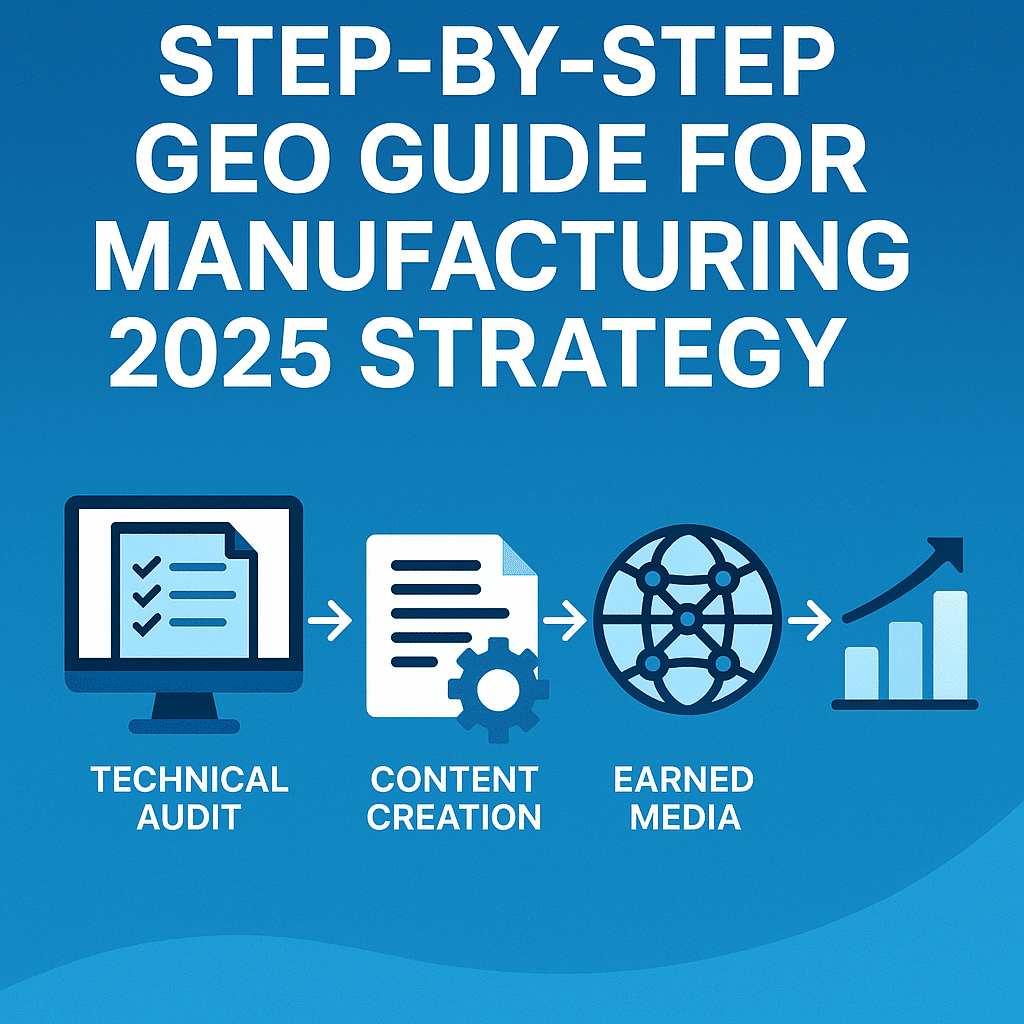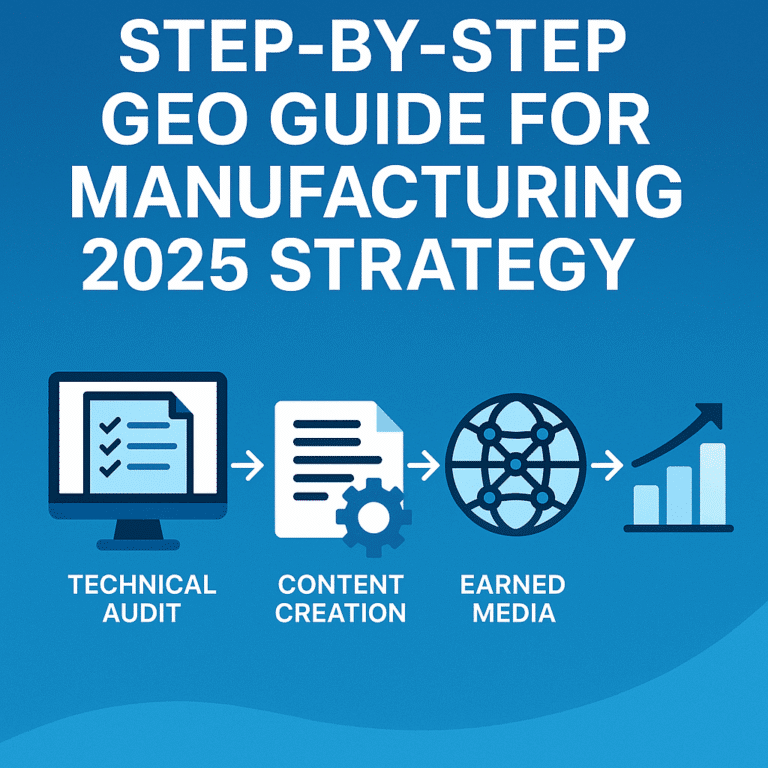Generative Engine Optimization (GEO) is reshaping how B2B buyers, engineers, and procurement managers in the manufacturing sector find solutions. Traditional search methods are now enhanced by AI-powered engines like ChatGPT, Gemini, and Perplexity, which are used for complex technical research. This guide provides a straightforward, step-by-step framework for manufacturers to create a successful GEO strategy for 2026, ensuring you are visible and cited by these new platforms.
Understanding the Shift: From SEO to GEO in Manufacturing
Generative Engine Optimization (GEO) is the practice of optimizing your digital content to be found, understood, and cited by AI answer engines. This is different from traditional Search Engine Optimization (SEO). SEO focuses on ranking your website in a list of links, while GEO aims to become the trusted source within a generated answer.
This is especially important for manufacturers. Your customers ask complex, solution-focused questions about technical specifications, compliance, and material science. A strong GEO strategy ensures your company’s data and expertise are featured in the AI-generated answers they receive. This change is happening across many industries, highlighting why it is important to know which agencies offer GEO services for B2B SaaS in 2026 and how this trend impacts your business.
Step 1: Conduct a Foundational Technical Audit
The first step is to ensure your digital assets are technically ready for AI crawlers. This means making sure that the AI has a clear path to find and understand your most important information.
Ensure Flawless AI Accessibility
For an AI to cite your content, it must first be able to access and index it without any issues. This requires a few technical checks.
- Optimize
robots.txt: This file tells search engine crawlers which pages on your site they can or cannot access. Make sure it allows AI crawlers to see your valuable content. - Implement Comprehensive Sitemaps: Sitemaps act as a roadmap for your website. A complete sitemap helps AI crawlers discover all your important pages, including product specifications and resources.
- Use Structured Data (Schema Markup): This is a type of code that helps search engines understand your content better. Use it to label key information like product specs, materials, and compliance standards, making it easy for AI to process.
Optimize for Geospatial and Location Intelligence
For manufacturing, location is a critical data point for supply chains, factory operations, and distribution. Making this geospatial data accessible to AI can set you apart. Location intelligence is already used in manufacturing for tasks like choosing factory sites and managing supply chain risks [1].
As smart manufacturing grows, there is an increased need for indoor awareness to track assets and workflows within a factory [2]. This merging of geospatial technologies with smart manufacturing systems is a key part of the industry’s future [3]. Offering clear location data is a core part of effective GEO services for manufacturing.
Step 2: Develop Authoritative, Solution-Oriented Content
Next, focus on creating deep, expert content that directly answers the questions of engineers, designers, and supply chain managers. The goal is to become the go-to source for reliable information in your field.
Create In-Depth Owned Media
Your company’s website, blog, and resource center are your most valuable platforms. Fill them with high-quality content that proves your expertise.
- Detailed technical white papers.
- Application-specific case studies.
- Downloadable CAD files and spec sheets.
- Articles on materials science and production processes.
This type of content establishes your company as a primary source of truth, not just a seller of products.
Address Complex Buyer Questions
To succeed with GEO, your content must address the specific, complex questions your technical audience is asking.
- “What is the best polymer for high-temperature automotive applications?”
- “Compare the tensile strength of steel alloy X vs. Y.”
- “How to integrate robotic arms in a CNC milling workflow?”
The future of manufacturing includes the use of immersive technologies and digital twins for virtual plant floor management [4]. Your content should speak to these advanced topics.
Step 3: Build Trust with Strategic Earned Media
Trust is built when reputable third-party sources cite your content and expertise. AI engines see these citations as a signal of authority and trustworthiness.
Secure Citations in Industry-Relevant Publications
Aim to get your company mentioned in trusted trade journals, academic research, and industry news sites. When AI crawlers see your brand cited by these sources, it confirms that your content is reliable. Target publications focused on supply chain management, logistics, and industrial technology. For instance, topics like optimizing supply chains with location intelligence are highly relevant [5].
Content that offers practical advice on how to use data to improve logistics is valuable to these publications [6]. Additionally, discussing the role of real-time location intelligence for greater efficiency is a timely subject [7].
Step 4: Measure GEO Performance and Business Impact
To measure the success of your GEO strategy, you need to look beyond traditional metrics like keyword rankings and organic traffic. New key performance indicators (KPIs) are needed for the AI era.
Adopt New Metrics for the AI Era
Focus on metrics that show your visibility within AI-generated answers.
- AI Visibility Score: How often your brand, products, or content appear in AI answers for relevant questions.
- Citation Frequency: How often AI engines cite your website as a source for their information.
- Share of Voice: Your brand’s visibility in AI answers compared to your competitors.
Connect GEO to Revenue and Market Penetration
The ultimate goal of GEO is to drive real business results. Tie your GEO KPIs back to core business objectives.
- Increase in qualified sales leads from engineering teams.
- Higher volume of RFQs (Request for Quotation).
- Penetration into new industrial markets.
For businesses with multiple factories or service centers, GEO should be part of a broader multi-location SEO strategy to ensure you are visible at every level.
Partnering for Success: Finding the Right GEO Agency
Implementing a GEO strategy for manufacturing requires specialized knowledge that generic marketing agencies may not have. It is important to find an expert partner to help guide your efforts. To find the right fit, you can review the top 8 GEO agencies for 2025 ranked by data.
CSP Agency‘s “Human-First” approach combines deep industry knowledge with AI-enhanced strategies to drive real business value. Our experience with complex B2B clients like Grid Dynamics and Charter Communications has prepared us to handle the unique challenges of the manufacturing sector.
Conclusion: Build Your Future-Proof Manufacturing Strategy Today
The four key steps to a strong GEO strategy are a technical audit, authoritative content creation, an earned media plan, and business-focused measurement. As AI becomes the main tool for technical research, manufacturers who do not adopt GEO risk becoming invisible. A human-first strategy that is aligned with your business goals is crucial for success.
Ready to build your 2025 GEO strategy? Connect with the experts at CSP Agency to get started.
Citations
- [1] https://esri.com/about/newsroom/publications/wherenext/location-intelligence-in-manufacturing
- [2] https://esri.com/about/newsroom/publications/wherenext/as-manufacturing-automation-increases-indoor-awareness-gains-attention
- [3] https://nist.gov/publications/merging-geospatial-echnologies-cross-reality-context-smart-manufacturing-systems
- [4] https://addletonacademicpublishers.com/search-in-emfm/3105-volume-18-4-2023/4781-geospatial-mapping-and-immersive-holographic-imaging-technologies-mobile-edge-computing-and-virtual-plant-floor-networks-and-computer-vision-artificial-intelligence-and-robotic-perceptual-systems-for-digital-twin-connected-factories-in-the-industrial-metaverse
- [5] https://levadata.com/post/top-5-ways-to-optimize-your-supply-chain-management-with-location-intelligence
- [6] https://experian.co.uk/blogs/latest-thinking/data-quality/5-ways-location-intelligence-can-help-optimise-supply-chain-management
- [7] https://corp.glympse.com/blog/glympse-empowers-businesses-with-real-time-location-intelligence-connecting-people-assets-and-operations-for-unparalleled-visibility-efficiency-and-safety-across-their-entire-supply-chain-and-custo

